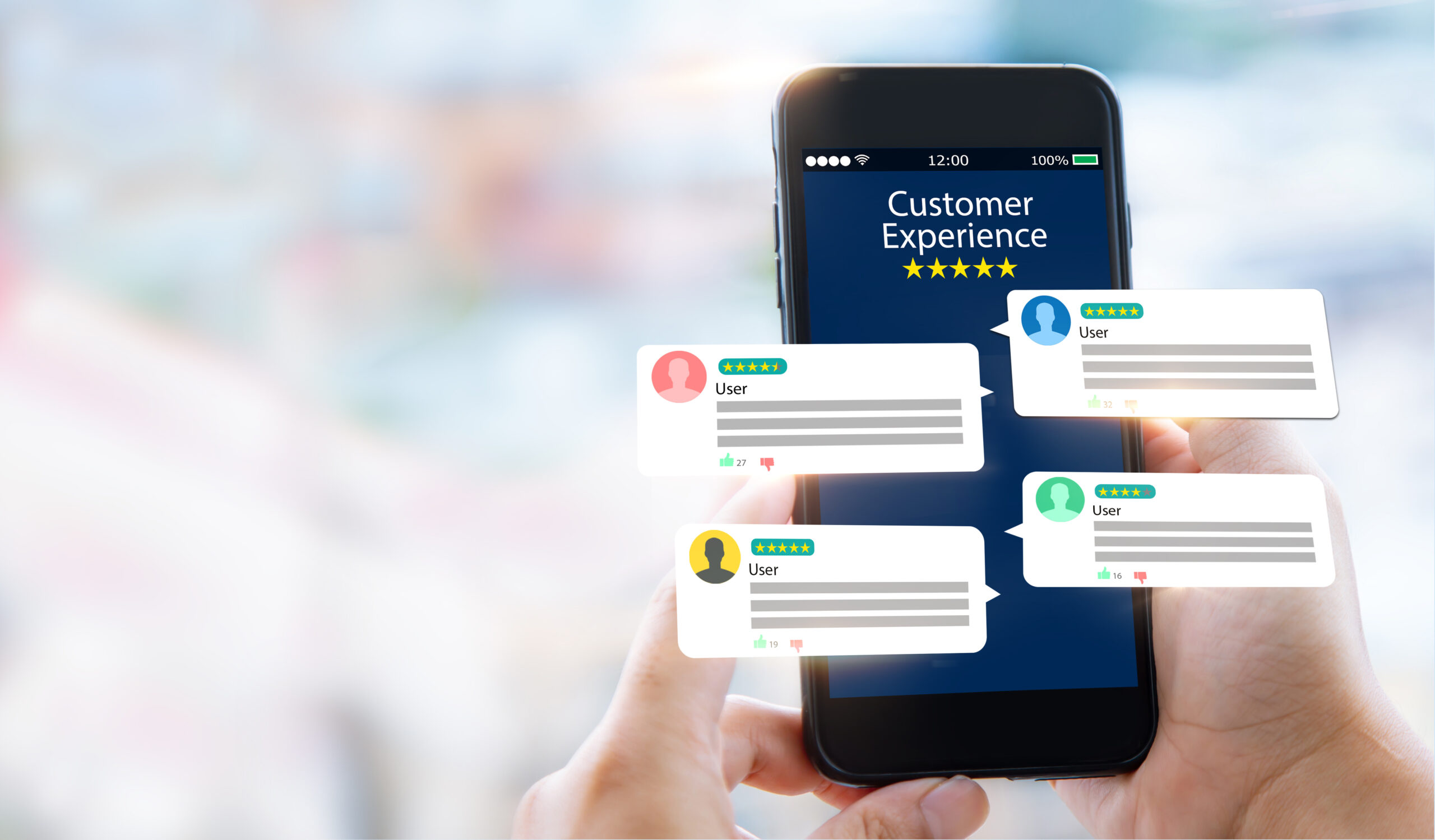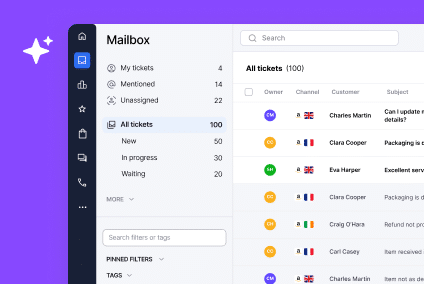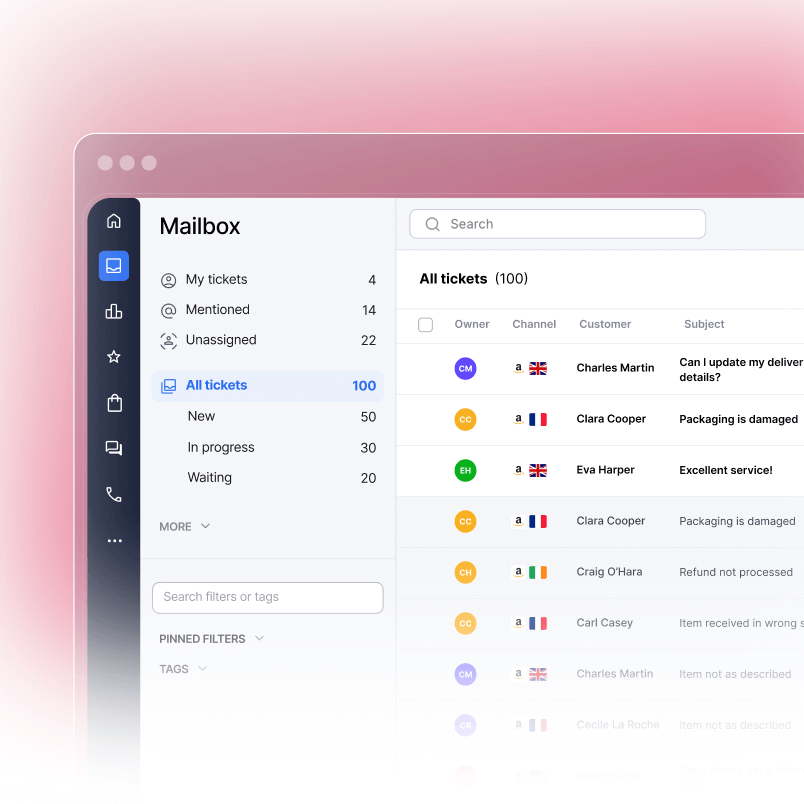Your customer buys on Amazon on Monday, leaves a question on Instagram Wednesday, and reaches out through your website on Friday. They expect you to remember all of it.
This is the reality of omnichannel selling. Customers move between channels effortlessly. Your support team shouldn’t have to search five different inboxes to understand what they want.
We’ll walk through how to build a unified customer experience across marketplaces, direct-to-consumer stores, and social channels. You’ll learn how to connect support, orders, and messaging so every customer feels heard, regardless of where they contact you.
Why Your Customers Expect a Unified Experience
The Reality of Omnichannel Shopping
The numbers tell a clear story. 71% of customers expect personalized experiences across all channels. Your brand voice, response speed, and knowledge of their history should feel the same whether you’re supporting Amazon or Shopify sales. This expectation isn’t negotiable. When you fail to meet it, customers abandon their purchases and switch to competitors.
Research shows that omnichannel customers spend 4% more in-store and 10% more online than single-channel customers. Brands with strong omnichannel customer experience strategies see significantly higher repeat purchase rates and better customer lifetime value. According to Plivo’s analysis of omnichannel statistics, 45% of firms saw better customer engagement, 35% retained more customers, and 35% reported improved customer loyalty due to omnichannel engagement.
When experiences aren’t unified, customers notice fast. They abandon carts. They leave negative reviews. They take their business elsewhere.
What Happens With Fragmented Support
Here’s what happens when support is scattered:
A customer asks about shipping on Amazon. Two days later, they message your Instagram. They have to repeat themselves. Response time drags. Frustration builds.
Unified support flips this. The same customer reaches out through any channel. Your team sees their complete history. They get help immediately. Brand trust strengthens.
How Consistency Impacts Revenue
This consistency directly impacts revenue. Faster resolutions reduce returns. Better experiences generate positive reviews. Repeat customers spend more. According to Marketing LTB’s 2025 omnichannel statistics, omnichannel shoppers have a 30% higher lifetime value compared to single-channel shoppers. Additionally, omnichannel retailers report 179% faster revenue growth than those without integrated strategies. When you invest in multichannel customer experience, you’re investing in revenue growth.
The Core Elements of Seamless Multichannel CX
Unified Order Visibility Across All Channels
Unified order visibility across channels forms the foundation. Your team needs to see Amazon orders, Shopify orders, eBay listings, and DTC transactions in one place. When support agents access a ticket, they should instantly know the customer’s purchase history, tracking status, and previous interactions. This is what separates good support from great support.
Consistent Brand Voice Everywhere
Consistent brand voice matters more than most brands realize. Whether a customer receives a reply on TikTok or through your website, the tone should match your brand. Your support responses should feel like your customer service, not a script read by five different people. This is why customer service templates and playbooks matter so much.
One Inbox, One Customer Profile
One inbox, one customer profile. This is simpler than it sounds but harder to execute without the right tools. When you consolidate Amazon, eBay, Walmart, Shopify, and social channels into a single helpdesk, context switching disappears. Agents stay focused. Response times drop. Research from Plivo shows that companies utilizing integrated omnichannel solutions experience a 31% reduction in first-resolution times and a 39% decrease in customer wait times compared to those operating in silos. A centralized helpdesk system becomes your competitive edge.
Real-Time Inventory and Tracking Data
Real-time inventory and tracking data prevents a common problem: promising information you don’t have. If an agent can’t see current stock or tracking numbers without leaving the support platform, they’ll give vague responses. Customers get frustrated. Build this data directly into your support view.
Respecting Marketplace Compliance Rules
Marketplace compliance matters more than most people think about. Amazon, eBay, and Walmart have specific rules about how you communicate. A unified platform needs to respect these constraints while still delivering personal service. Understanding these limitations helps you navigate marketplace restrictions effectively. Learn more about managing support on multiple marketplaces. Data shows that 73% of customers engage across multiple channels during their buying journey, making compliance across all platforms essential.
Obstacles You’ll Face When Unifying Multichannel Support
Fragmented Data Across Systems
Fragmented data sits at the top of the list. Orders live in different systems. Customer data spreads across platforms. Building a single source of truth takes work. This is why choosing the right ecommerce customer support software is critical from day one.
Repetitive Customer Conversations
Repetitive conversations drain your team’s efficiency. A customer asks the same question across two channels because their first message went unanswered or they didn’t get a response they understood. This happens more often with high volume sellers. Automation can help here without sacrificing quality.
Time Lost to Context Switching
Context switching creates delays. Your team opens Amazon, checks email, hops to Shopify, then Instagram. Each switch wastes seconds. Across hundreds of tickets daily, these seconds add up to hours of lost productivity. This is the hidden cost of fragmented support systems.
Marketplace Restrictions Create Friction
Marketplace restrictions create friction. You can’t always respond the way you’d like on Amazon. You can’t link to your website on eBay. These constraints are real. Your system needs to work within them. Understanding Amazon seller messaging rules and eBay seller policies helps you navigate these limitations.
Different Customer Expectations by Channel
Different channels have different customer expectations. A DTC customer expects personalized service. A marketplace buyer expects speed. Your workflow needs to adapt to both. This flexibility is what makes or breaks scaling.
How to Build Your Unified Multichannel CX System
Start With Centralized Helpdesk Software
Start with centralized helpdesk software. This is your command center. It should connect Amazon, eBay, Walmart, Shopify, Instagram, Facebook, and any other channel where customers reach you. All messages flow into one inbox. All customer profiles feed from one database. A unified helpdesk eliminates support silos and keeps your team working efficiently. Look for platforms that offer real-time order sync and intelligent routing.
Connect Real-Time Order Data to Support
Connect real-time order data to your support view. When an agent opens a ticket, they should see:
Order confirmation details Current fulfillment status Tracking information Return history Product details Previous support interactions
This eliminates the need to open separate tabs or search for information. Faster responses follow naturally. Many teams cut their response time by 30-40% just by implementing this single change.
Standardize Your Messaging Approach
Standardize your messaging approach. Create templates for common scenarios. Include marketplace-compliant versions where necessary. Build macros that agents can customize quickly without starting from scratch every time. This is where customer service automation delivers real value.
Set Up Cross-Channel Reporting
Set up cross-channel reporting. Track response times, customer satisfaction, and ticket volume by channel. See which channels need more resources. Identify patterns. Adjust staffing and training based on real data. Understanding your customer service metrics across channels shows you where to invest.
Build a CX Playbook for Your Brand
Build a CX playbook specific to your brand. This document should cover:
Tone and voice guidelines How to handle refunds across channels Escalation procedures Response time expectations How to mention your DTC store on marketplace channels (within rules) When and how to take conversations offline
Train Your Team on Channel-Specific Nuances
Train your team on channel-specific nuances. Marketplace support feels different from DTC support. Your agents need to understand these differences. They need to know marketplace restrictions. They need to stay compliant while building customer relationships. Investing in agent training pays dividends in customer satisfaction.
Automate the Low-Value Work
Automate the low-value work. Order status questions, return inquiries, tracking links. Bots can handle these instantly. Free your team for complex issues that require human judgment. Customer service automation properly implemented keeps your team focused on what matters.
Tools Built for Multichannel Support
eDesk for Marketplace Sellers
eDesk specializes in high-volume multichannel support for sellers on Amazon, eBay, Walmart, and Shopify. Your team gets one unified inbox with order data syncing in real-time. Response time trackers keep everyone accountable. The platform was built specifically for the challenges marketplace sellers face. You get SLA management, intelligent routing, and native marketplace compliance built in.
Gorgias for DTC Brands
Gorgias works best for DTC brands focused on Shopify. It connects Instagram, Facebook, email, and SMS with native Shopify integration. Macros help speed up responses. Intent detection flags urgent issues automatically. If your business is primarily direct-to-consumer, Gorgias offers strong workflow automation.
ChannelReply for Zendesk Users
ChannelReply layers marketplace support on top of Zendesk. It pulls marketplace orders into your Zendesk workflow. If you’re already invested in Zendesk, this bridges the gap without requiring a platform switch. This approach works well for enterprises already standardized on Zendesk.
How to Choose the Right Tool
The right choice depends on your channel mix. High-volume marketplace sellers benefit from eDesk’s specialization and marketplace-first design. DTC-focused brands find speed in Gorgias. Teams already using enterprise helpdesk software might layer on ChannelReply. When evaluating options, consider your channel distribution, team size, and growth plans.
Workflow Design for Consistency
Create a Ticket Triage System
Create a ticket triage system based on channel and urgency. Some issues need immediate attention. Others can wait a few hours. Automate basic triage so urgent tickets reach senior agents first. This keeps your best people working on your hardest problems.
Use Smart Routing
Use smart routing. Send marketplace support tickets to team members trained on marketplace rules. Route returns to your returns specialist. Build workflows that respect expertise. Smart routing cuts resolution time and improves consistency.
Set Response Time SLAs by Channel
Set response time SLAs by channel. Marketplace buyers expect speed. DTC customers appreciate thorough responses even if they take an hour longer. Different channels, different standards. Document these and measure against them weekly.
Build an Escalation Path
Build an escalation path. When a ticket gets complex, who handles it? What’s the handoff process? Document this clearly. Practice it. Make escalations smooth. Clear escalation paths prevent tickets from falling through cracks.
Create a Feedback Loop
Create a feedback loop. When customers respond to support, what happens? Do you track sentiment? Do you learn from every interaction? The best multichannel support systems improve constantly. Use customer feedback to refine your workflows monthly.
Real Examples of Multichannel CX Success
Reducing First-Response Time by 35%
A seller consolidating Amazon and eBay support into one helpdesk reported a 35% reduction in first-response time. Their agents stopped wasting time switching between systems. Consistency in response quality improved. Customer satisfaction ratings climbed across both channels. This seller went from 8-hour response times to 5-hour response times in two weeks.
Building Trust Across Marketplaces
Another brand unified DTC and marketplace support. Before the change, marketplace customers felt disconnected. After integration, Amazon sellers started recognizing they were dealing with the same support team. Trust built faster. Returns dropped 12%. Customer lifetime value increased by 18% within three months.
Automating Low-Value Tickets
A high-volume seller automated status update requests. These tickets disappeared. Their team focused on complex issues. First-response time dropped from 6 hours to 2 hours. Customer satisfaction scores jumped 18%. The payoff was immediate and measurable.
Building Your Multichannel CX Strategy
Start Small and Expand
Start small if you need to. Maybe you’re on Amazon and Shopify. Get those two channels unified first. Prove the value. Then add marketplace channels. Then integrate social. This phased approach reduces implementation risk and lets your team adjust gradually.
Prioritize Based on Volume
Prioritize based on volume. Which channel brings the most customers? Start there. Make that experience perfect. Then expand. Your highest-volume channel should be your pilot for new processes and tools.
Balance Automation With Personality
Don’t sacrifice quality for speed. Automation helps with volume. But your core support still needs personality. Customers can tell when they’re talking to a template versus a person who cares. The best approach uses automation for triage and low-value work, then pairs it with skilled humans for everything else.
Invest in Your Team
Invest in your team. Train them well. Give them good tools. Unified support software only works if your team knows how to use it. Make training part of your implementation plan. Your team is your competitive advantage.
Measure What Matters
Measure what matters. Track response time, satisfaction, resolution rate, and channel-specific metrics. Not all channels behave the same. Not all metrics matter equally. Focus on the numbers that drive revenue. Set targets quarterly and review progress monthly.
What Unified Multichannel Support Means for Your Business
Consistency Builds Trust
Consistency builds trust. Customers feel heard. They return. They recommend you to others. Trust is the foundation of customer loyalty and repeat purchases. When you deliver consistent experiences, you build a competitive moat.
Speed Compounds
Speed compounds. When your team stops context switching, they respond faster. Faster response drives satisfaction. Satisfied customers spend more. A 35% improvement in response time often translates to a 12-18% improvement in repeat purchases.
Efficiency Grows
Efficiency grows. Your team handles the same volume with fewer people. Training becomes simpler. Compliance becomes automatic. Costs go down. Most sellers report a 25-30% reduction in per-ticket support costs after unifying their channels.
Scale Becomes Possible
Scale becomes possible. Most sellers hit a growth ceiling when support breaks. Unified systems let you scale without hiring proportionally. You handle 3x the volume with 2x the team. This is how scaling profitably works.
Competitive Advantage Emerges
Competitive advantage emerges. Your competitors are still juggling five different inboxes. You’re not. You’re faster, more consistent, and more responsive. These differences feel real to customers. Over time, this advantage compounds into market share gains.
Elevate Your Multichannel CX with a Unified Support System
Delivering a consistent multichannel customer experience isn’t just a support upgrade—it’s a business growth strategy. By unifying your order data, streamlining communication, and maintaining a consistent brand voice across every touchpoint, your team builds the kind of trust that keeps customers coming back. The faster you respond and the more connected your systems are, the easier it becomes to scale efficiently while improving satisfaction.
If you’re ready to simplify your multichannel support and delight customers on every platform, start today with eDesk’s unified helpdesk. It’s the easiest way to centralize all your ecommerce conversations and turn every interaction into a loyalty opportunity.
FAQs
How do I manage customer support across multiple ecommerce channels?
Consolidate all channels into a centralized helpdesk platform. Connect Amazon, eBay, Shopify, and social channels to one inbox. Pull order data into your support view. Use templates and automation for routine issues. Train your team on channel-specific rules. Start with your highest-volume channel and expand from there.
What’s the best tool for multichannel support?
It depends on your channel mix. If you sell on multiple marketplaces, eDesk integrates all major channels and is built for marketplace sellers. If you’re DTC-focused on Shopify, Gorgias moves fast. If you use Zendesk, ChannelReply adds marketplace support. Evaluate based on your specific channels and growth plans.
How do I keep messaging consistent across different platforms?
Create a brand voice guide. Write templates for common scenarios. Include marketplace-compliant versions where rules differ. Use macros so agents don’t start from scratch. Review responses regularly for consistency. When you automate customer support well, this becomes easier to enforce across your entire team.
Can I automate support without losing the personal touch?
Yes. Automate repetitive work like status requests and return initiations. Keep complex issues and relationship-building with humans. The best multichannel support combines automation for volume with human touch for problems that matter. Most sellers find that 40-50% of tickets can be automated without harming customer relationships.
How long does it take to implement a unified multichannel support system?
Implementation typically takes 2-4 weeks. You integrate channels, set up order data sync, build templates, and train your team. Start with your highest-volume channel. Add others once the first one runs smoothly. Brands report that the effort pays back quickly through faster response times and improved customer satisfaction.
What metrics should I track across channels?
Track response time, customer satisfaction scores, resolution rate, and ticket volume by channel. Monitor repeat customer rates. Track customer sentiment. Measure first-contact resolution. Use these metrics to improve workflows and staffing decisions. Your customer service metrics vary by channel, so set realistic SLAs for each one and review monthly.




